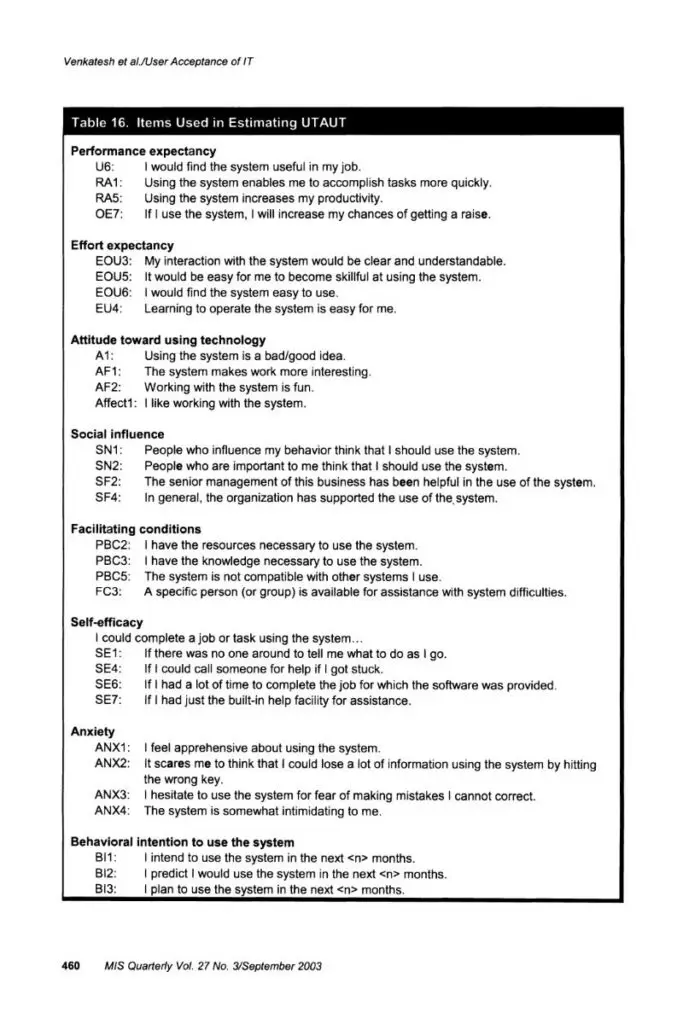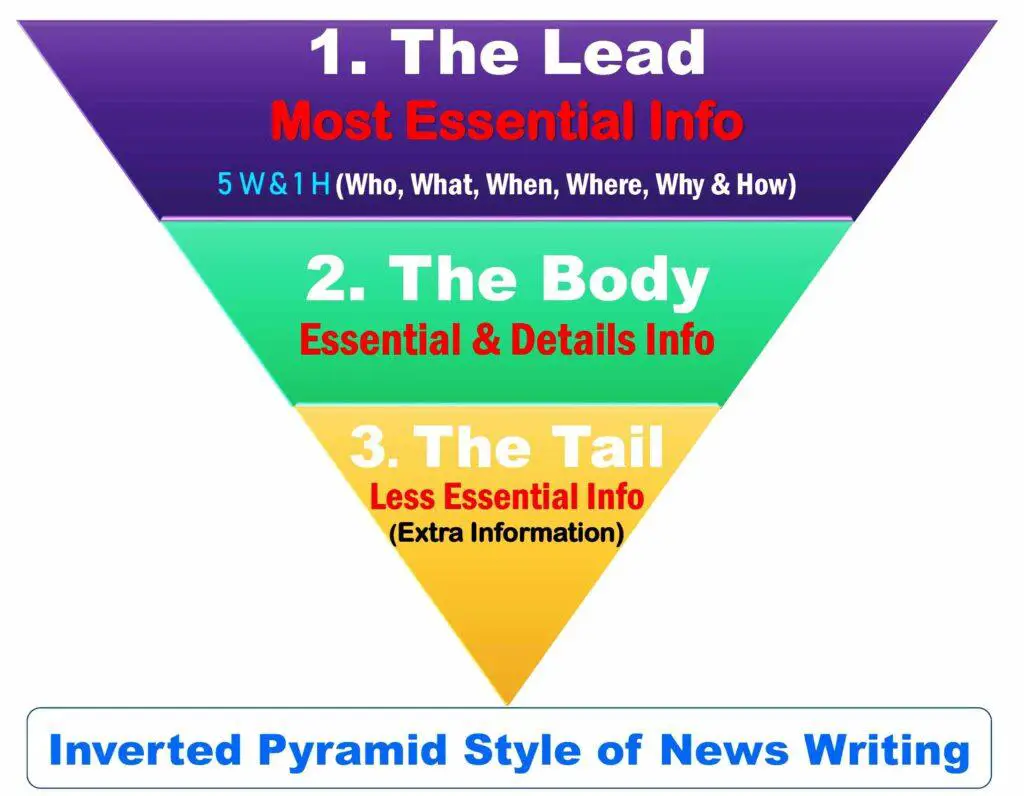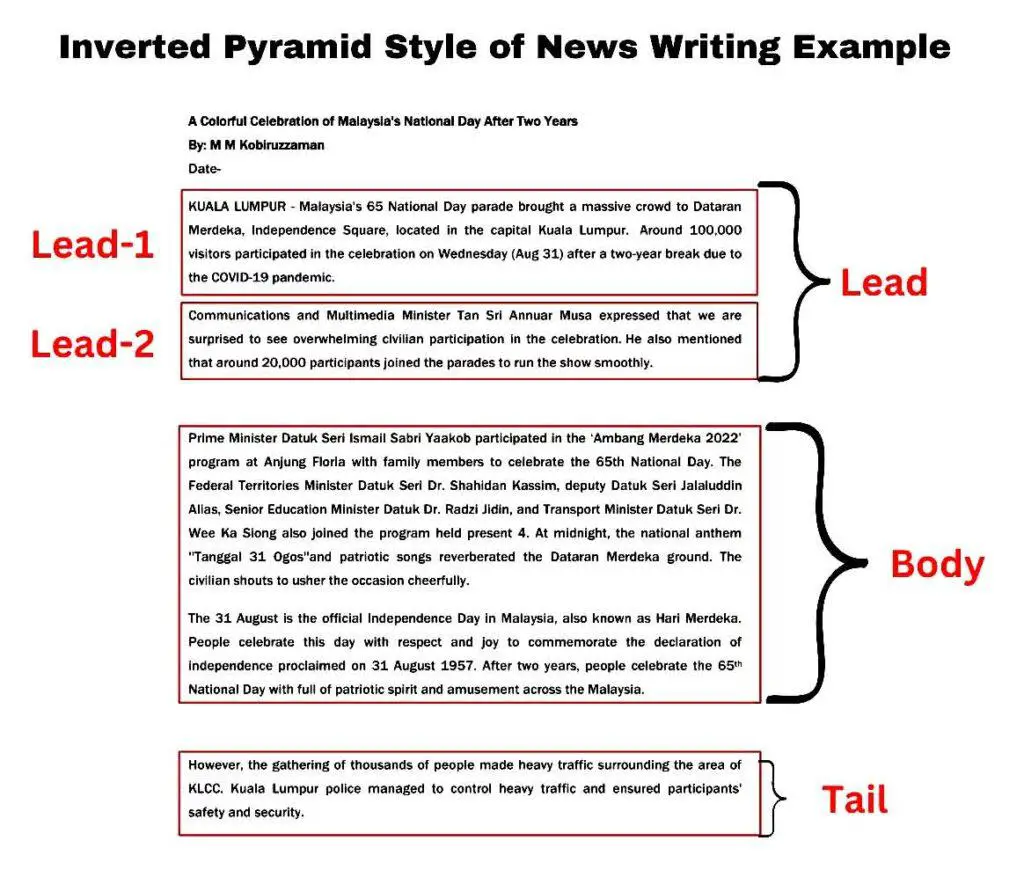This article explains the UTAUT Model or Unified Theory of Acceptance and Use of Technology and its Variables, Questionnaires, Examples, Strengths, and Limitations. It also demonstrates the UTAUT Model Venkatesh Questionnaire.
UTAUT Model
The UTAUT model refers to the Unified Theory of Acceptance and Use of Technology, developed by Venkatesh, Davis, Morris, and Davis in 2003. UTAUT is the short form of the Unified Theory of Acceptance and Use of Technology. The unified theory of acceptance and use of technology (UTAUT) is one of the most up-to-date and widely accepted models of technology adoption. This study used a longitudinal qualitative design and found that around 70% of Behavioral Intention to Use (BI) and about 50% of actual use.
Viswanath Venkatesh and other authors proposed this theory based on the review of eight models that examine factors affecting the usage behavior of information systems. It is an extended theory of the eight-technology adoption models. The authors mentioned the eight theories in the paper’s abstract section. The UTAUT model was adopted from eight earlier models.
The eight models adopted for the UTAUT model development are as follows:
- Theory of Reasoned Action (TRA)
- Technology Acceptance Model (TAM)
- Motivational Model (MM)
- Theory of Planned Behavior
- Combined Theory of Planned Behavior/Technology Acceptance Model
- Model of Personal Computer Use
- Diffusion of Innovations Theory (DIT)
- Social Cognitive Theory (SCT)
The authors collected and used data from four organizations over six months to observe and record changes in variables. The data were analyzed through three points of measurement. Based on the literature on user acceptance, the UTAUT model is widely used to identify factors that influence users’ adoption of new technologies and information systems. Venkatesh et al. (2003) identified four constructs that directly and indirectly determine users’ system use motivation.
The three constructs (1. Performance Expectancy, 2. Effort Expectancy, and 3. Social Influence) determine the intention to use the technology through behavioral intention. The fourth characteristic (Facilitating Conditions) directly determines the intention to use the technology. The UTAUT model also presents four moderator variables (Age, Gender, Experience, and Voluntariness of Use).

UTAUT Model Basic Info
Authors: Viswanath Venkatesh, Michael G. Morris, Gordon B. Davis, and Fred D. Davis
Title: “User acceptance of information technology: Toward a unified view”
Publishers: Management Information Systems Research Center, University of Minnesota
DOI URL: https://www.jstor.org/stable/30036540
Research Strategy: Survey
Methodological Choice: Mono-method Qualitative
Time Horizon: Longitudinal
The Management Information Systems Research Center, University of Minnesota, published the UTAUT model in 2003 under the title of USER ACCEPTANCE OF INFORMATION TECHNOLOGY: TOWARD A UNIFIED VIEW.

Unified Theory of Acceptance and Use of Technology (UTAUT) Model
Previous research validates the unified theory of technology acceptance and use as a comprehensive theoretical model for predicting the adoption intention of new technologies and systems across different contexts. Consequently, the UTAUT model provides an in-depth understanding of the factors that predict individuals’ acceptance and use of new systems or tools. The UTAUT model describes why and how users adopt new systems and technology. This theory posits that performance expectancy, effort expectancy, facilitating conditions, and social influence influence people’s use of new systems in social and organizational contexts.
Many researchers extended this theory to understand factors influencing the acceptance of new systems in different contexts. For example, in 2012, Venkatesh, L. Thong, and Xin Xu extended the UTAUT model to examine consumer acceptance and use of technology.
Variables of the UTAUT Model
What are the determinants of the Unified Theory of Acceptance and Use of Technology (UTAUT) Model?
The UTAUT model comprises four independent or predictor variables (1. Performance Expectancy, 2. Effort Expectancy, 3. Social Influences, 4. Facilitating Conditions), four moderators (1. Age, 2. Gender, 3. Experience, 4. Voluntariness of Use), and a dependent variable (Behavioral Intention).
The Elements of the UTAUT Model are:
- Performance Expectancy
- Effort Expectancy
- Social Influences
- Facilitating Conditions
- Behavioral Intention and Use Behavioral
- Moderating Variables (Age, Gender, Experience, and Voluntariness of Use)
The Additional Variables of the UTAUT Model are:
- Gender
- Age
- Experience
- Voluntariness of use
1. Performance Expectancy (PE)
Performance expectancy is a predictor variable that considers how the new system will help users improve performance in completing the task (Venkatesh et al., 2003). It validates why the new system is advantageous for individual performance and improves efficacy. It also simulates the decision-making process behind their use of the system. In a social context, people accept new technology when they see benefits. Performance expectancy describes the importance of new systems and technology, influencing a person to use the latest technology. Based on the UTAUT model, the researcher can hypothesize that when people perceive new systems and technologies as helpful tools, they will use them in personal, social, and professional contexts. In sum, Performance expectancy will positively influence users to accept and use the new system to complete a particular task.
2. Effort Expectancy (EE)
Effort expectancy is another crucial independent variable that considers how easy and effortless it will be to complete the tasks with the new technology (Venkatesh et al. 2003). Researchers employ this construct to examine ease of use. It represents the extent to which users find modern technology easy to learn and operate. Effort expectancy demonstrates the ease and effortlessness of using the new technology. People will adopt new technology if the tools are easy to use, which affects their decision to adopt a particular technology.
However, users might not adopt the new system if it is challenging to operate and takes much longer than the previous technique. Effort expectancy is a crucial factor in making adoption decisions at the beginning stage. According to the UTAUT model, people prefer new systems and tools that are easy to use and clear and understandable. Based on the above discussion, the researcher hypothesizes that if people perceive the new system as a trouble-free, effortless tool, they will adopt it in personal, social, and professional environments. Hence, Effort expectancy will influence new users to accept and use them positively.
3. Social Influence (SI)
Social influence is the degree to which users prioritize other beliefs, which is why they should utilize the new system (Venkatesh et al. 2003). It directly affects others’ behavioral intentions to adopt the technology. People change their technology use behaviors when they consider that others benefit from the new technology (Peng & Miller, 2021; Mortenson & Vidgen, 2016). Social influence can come from friends, colleagues, family members, relatives, and managers. It happens at the initial stage when people are expected to meet their own and others’ expectations. For example, people adopt the WeChat tool for social media news use because they get recommended and suggested by peers. Based on the UTAUT model, researchers can hypothesize that people adopt new systems to complete specific tasks when they observe others using them for the same purpose. Therefore, Social influence will influence users to accept and use new tools positively.
4. Facilitating Conditions (FC)
According to the UTAUT model, the facilitating condition is the degree to which an individual believes the organization provides infrastructural, resource, and technical support for the new system. It ensures the organization’s capability to adopt the latest tools to complete tasks. For example, IT companies can easily adopt artificial intelligence because they have skilled human resources and the technology to use it properly. In this scenario, experienced employees and modern technology facilitate the adoption of the new system.
Based on the UTAUT model, researchers can hypothesize that people utilize new systems to complete complex tasks if they observe that they have the technical and infrastructural resources to operate them. Therefore, the Facilitating Condition will influence users to accept and use new tools positively.
5. Behavioral Intention (BI)
Behavioral Intention (BI) is the dependent variable and central element of the Unified Theory of Acceptance and Use of Technology (UTAUT) model. It is defined as the individual’s intention to use a new technology or information system. It is considered that a person will actually use the technology. Essentially, BI measures an individual’s readiness or plan to adopt and utilize a new system.
Use Behavioral
Use Behavior (UB) is the ultimate dependent variable in the UTAUT model. The outcome being predicted is also known as Actual Use Behavior. The UB is the outcome variable in the Unified Theory of Acceptance and Use of Technology (UTAUT). In the context of the UTAUT model, Use Behavior is the observable, measurable act of actually using the technology or information system in real life.
6. Moderating Variables (Age, Gender, Experience, and Voluntariness of Use)
The UTAUT model also includes four moderating variables: age, gender, experience, and voluntariness of use. These variables affect the strength of the relationships between the dependent variables (Performance Expectancy, Effort Expectancy, Social Influences, Facilitating Conditions) and the independent variable (Behavioral Intention).
UTAUT Model: Moderating Factors
- Gender: Moderates only three variables (PE, EE, and SI).
- Age: Moderates all four variables (PE, EE, SI, and FC).
- Experience: Moderates only three determinants (EE, SI, and FC).
- Voluntariness of use: Moderates only the relationship between Social Influence (SI) and Behavioral Intention (BI).
UTAUT Model Venkatesh Questionnaire
Venkatesh and other authors used the following items to estimate the UTAUT model, also known as the Unified Theory of Acceptance and Use of Technology (UTAUT). However, the authors removed the three determinants —self-efficacy, anxiety, and attitude —from the model. Finally, they retained four determinants that were predictive. The researchers have adopted these research questionnaires to conduct diverse research in different contexts.
For example, Abdullah M. Baabdullah adopted UTAUT model questionnaires to validate his research questionnaire, estimating “The precursors of AI adoption in business.”

Item Used To Estimate UTAUT Model Hypotheses
Performance Expectancy
U6: I would find the system useful in my job. RA1: Using the system enables me to accomplish tasks more quickly. RA5: Using the system increases my productivity. OE7: If I use the system, I will increase my chances of getting a raise.
Effort Expectancy
EOU3: My interaction with the system would be clear and understandable. EOU5: It would be easy for me to become skillful at using the system. EOU6: I would find the system easy to use. EU4: Learning to operate the system is easy for me.
Attitude Toward Using Technology
A1: Using the system is a bad/good idea. AF1: The system makes work more interesting. AF2: Working with the system is fun. Affect1: I like working with the system.
Social Influence
SN1: People who influence my behavior think that I should use the system. SN2: People who are important to me think that I should use the system. SF2: The senior management of this business has been helpful in the use of the system. SF4: In general, the organization has supported the use of the system.
Facilitating Conditions
PBC2: I have the resources necessary to use the system. PBC3: I have the knowledge necessary to use the system. PBC5: The system is not compatible with other systems I use. FC3: A specific person (or group) is available for assistance with system difficulties.
Self-Efficacy (Dropped)
I could complete a job or task using the system... SE1: If there was no one around to tell me what to do as I go. SE4: If I could call someone for help if I got stuck. SE6: If I had a lot of time to complete the job for which the software was provided. SE7: If I had just the built-in help facility for assistance.
Anxiety (Dropped)
ANX1: I feel apprehensive about using the system. ANX2: It scares me to think that I could lose a lot of information using the system by hitting the wrong key. ANX3: I hesitate to use the system for fear of making mistakes I cannot correct. ANX4: The system is somewhat intimidating to me.
Behavioral Intention to Use the System
BI1: I intend to use the system in the next <n> months. B12: I predict I would use the system in the next <n> months. B13: I plan to use the system in the next <n> months.
UTAUT Model Limitations
The author has collected the following limitations and shortcomings of the UTAUT model from several top papers. Firstly, the authors analyzed secondary rather than primary data, which is a limitation of this model. Primary data are convenient for assessing mediators and moderators. An additional shortcoming of the UTAUT model is the variability in findings across longitudinal research designs, as long-term studies may yield unexpected results.
UTAUT Model Significance
The academic significance of the Unified Theory of Acceptance and Use of Technology model includes Theory Consolidation, Strong Predictive Power, Identification of Key Variables, Inclusion of Moderating Variables, and Foundation for Future Research.
The practical significance of the UTAUT model includes an Evidence-Based Tool, Problem Identification, Multidimensional Evaluation, and Targeted Interventions.
Difference Between TAM and UTAUT Model
| Aspect | Technology Acceptance Model (TAM) | Unified Theory of Acceptance and Use of Technology (UTAUT) |
| Origin & Developers | Developed by Fred Davis (1986, 1989) as an extension of the Theory of Reasoned Action (TRA). | Developed by Venkatesh et al. (2003) by integrating eight previous technology adoption models, including TAM, TRA, TPB, and more. |
| Purpose | To explain users’ acceptance of technology through two central beliefs: usefulness and ease of use. | To create a unified, more comprehensive model that improves the prediction of technology acceptance and usage behavior. |
| Key Constructs | 1. Perceived Usefulness (PU) – belief that technology improves performance. 2. Perceived Ease of Use (PEOU) – belief that technology is free of effort. These lea 2. Lead to Attitude, Behavioral Intention, and Actual Use. |
1. Performance Expectancy (PE) – similar to PU. 2. Effort Expectancy (EE) – similar to PEOU. 3. Social Influence (SI) – influence from people who matter. 4. Facilitating Conditions (FC) – resources/support available. Leads directly to Behavioral Intention and Use Behavior. |
| Model Complexity | Simple and easy to apply; widely used in academic studies. | More complex with additional constructs and moderators, but provides better predictive accuracy. |
| Moderating Variables | Uses fewer moderators, such as experience or demographic factors (not originally included). | Includes Age, Gender, Experience, and Voluntariness of Use as key moderators, strengthening predictive power. |
Predictive Power |
Moderate predictive ability (~40% variance explained in intention). | High predictive ability (up to 70% variance explained in intention). |
| Attitude Toward Use | Explicitly includes Attitude as a mediator between beliefs and intention. | Attitude is removed; UTAUT assumes that core constructs already capture user motivation. |
| Focus of Measurement | Measures individual cognitive beliefs (usefulness and ease). | Measures cognitive, social, and organizational influences on usage. |
| Strengths | – Simple and widely validated. – Easy to adapt and modify. – Useful for early-stage technology studies. |
– High explanatory power. – Considers social and institutional factors. – Effective for organizational and workplace technologies. |
| Limitations | – Ignores social and facilitating factors. – Oversimplified for complex organizational environments. – Limited predictive accuracy. |
– More difficult to apply due to complexity. – Requires detailed data for moderators. – May be less suitable for small-scale studies. |
| Best Use Cases | Suitable for studies on basic consumer technologies, apps, websites, or early user acceptance. | Suitable for workplace, enterprise systems, e-learning platforms, and contexts with strong social/organizational influence. |
| Overall Difference Summary | TAM is simpler, focuses on two beliefs (PU & PEOU), and is primarily cognitive. | UTAUT is more holistic, combining cognitive, social, and organizational factors for stronger predictive power. |
APA Citation 7th Edition For UTAUT Model
Venkatesh, V., Morris, M. G., Davis, G. B., & Davis, F. D. (2003). User acceptance of information technology: Toward a unified view. MIS Quarterly, 425-478.

